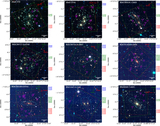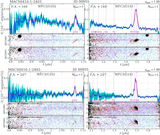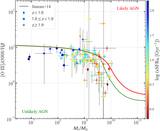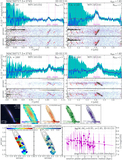Image Details
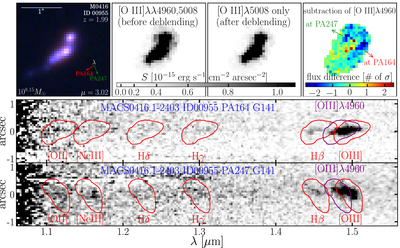
Caption: Figure 3.
Our custom technique of obtaining pure ﹩[{\rm{O}}\,{\rm\small{III}}]﹩ λ5008 maps combined from multiple orients of grism exposures. Top, from left to right: color-composite image of object MACS 0416–ID 00955 (a z ∼ 2 dwarf galaxy with ﹩{M}_{* }﹩ ≃ 108 ﹩{M}_{\odot }﹩), its ﹩[{\rm{O}}\,{\rm\small{III}}]﹩ map before deblending the ﹩[{\rm{O}}\,{\rm\small{III}}]﹩ doublets, its pure ﹩[{\rm{O}}\,{\rm\small{III}}]﹩ λ5008 map clean from the partial contamination of ﹩[{\rm{O}}\,{\rm\small{III}}]﹩ λ4960 at two orients (PA164 and PA247), and the significance of the difference between these two ﹩[{\rm{O}}\,{\rm\small{III}}]﹩ maps. The significance is expressed as the flux differences divided by the corresponding flux uncertainties (i.e., σ) of ﹩[{\rm{O}}\,{\rm\small{III}}]﹩ λ5008 in each spatial pixel. Middle and bottom: 2D contamination and continuum-subtracted G141 spectra of this dwarf galaxy at two orients (PA164 and PA274) separately. Note that these 2D traces are basically cutouts from the continuum-subtracted G141 spectra presented in Figure 2. Due to the limited spectral resolutions of HST grisms and extended source morphology, fluxes of ﹩[{\rm{O}}\,{\rm\small{III}}]﹩λ4960 are blended into ﹩[{\rm{O}}\,{\rm\small{III}}]﹩λ5008 and Hβ in a spatially inhomogeneous fashion, specific to the light dispersion direction at individual orients.
Copyright and Terms & Conditions
© 2020. The American Astronomical Society. All rights reserved.


